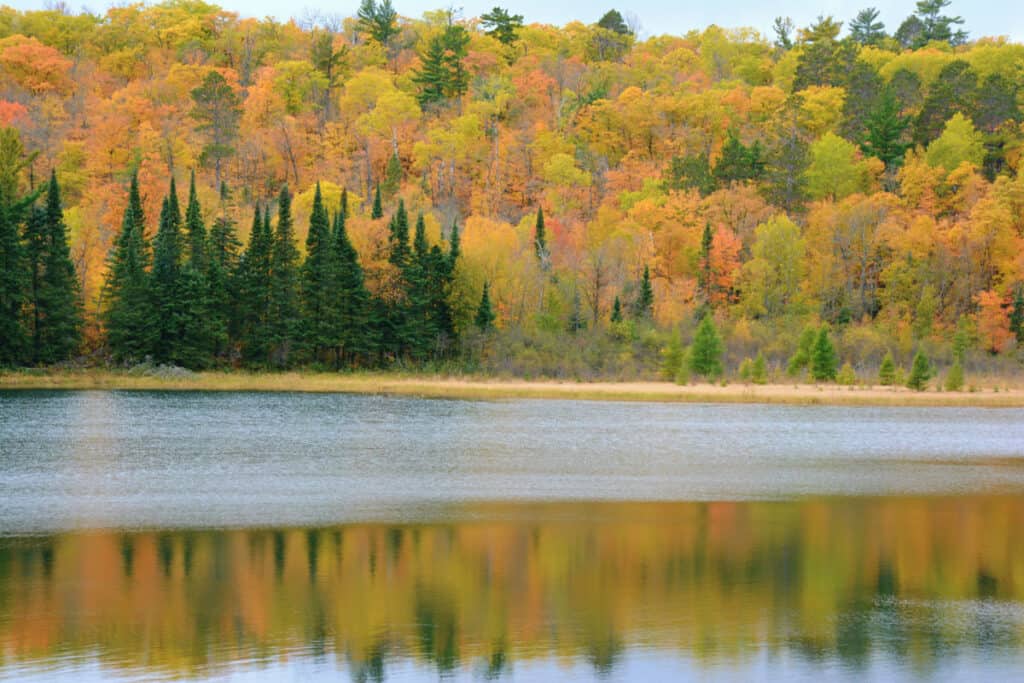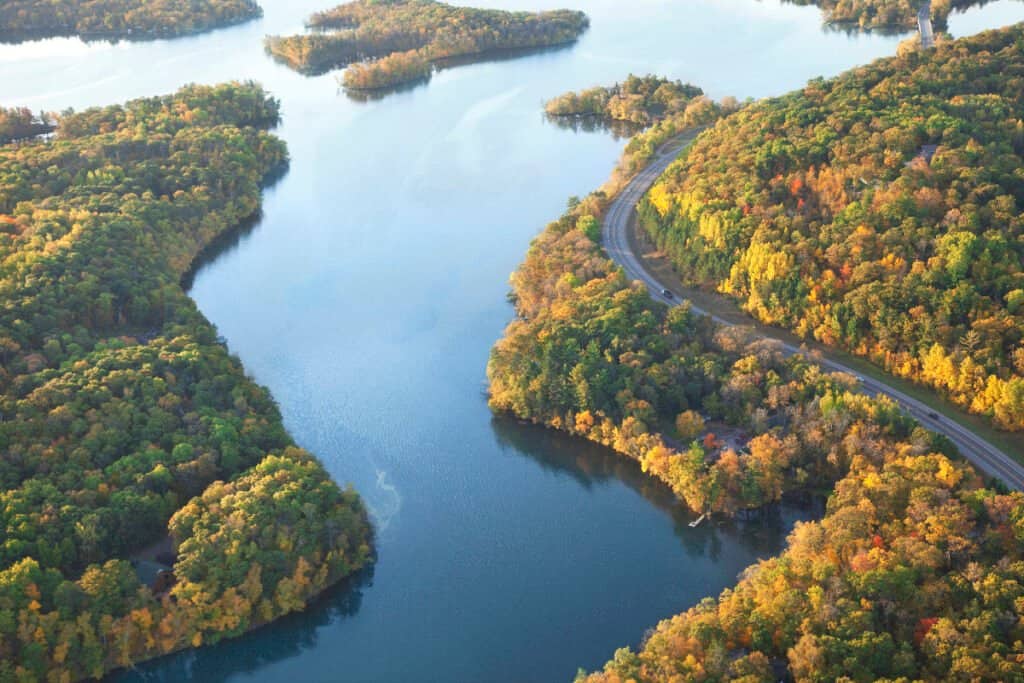Key Points:
- The Mississippi is the second-longest river in the United States.
- It flows from Minnesota’s Lake Itasca, in Itasca State Park.
- It flows through 10 states including Arkansas, Illinois, and Iowa.
The Mississippi River is one of the largest rivers in the world and the second largest in North America. The 2,350-mile body of water has been crossed for exploration, used for transportation, and has been the subject of many works of fiction. However, anyone who studies bodies of water would agree that rivers are somewhat odd, and that it can be hard to discover their origin. After all, not all rivers are well-defined throughout their run.
River sources, or “headwaters,” often stem from several smaller streams flowing into each other. Rainfall and mountain snow melt, even groundwater, can act as headwaters. Tracing the origin of these tributaries can be difficult and even mysterious, sometimes. The Mississippi River falls into this category. So, we’re going to take a closer look in order to answer the question, where does the Mississippi River start?
By the time we’re done here, you’ll learn all about this unique body of water and all the places where it flows!
Where Does the Mississippi River Start?

The Mississippi River starts in Lake Itasca iin Minnesota, seen here in the Autumn.
©iStock.com/Jeff439
The Mississippi River starts in Lake Itasca, an area of Minnesota that is rife with other lakes. This lake is fed by several streams and marks the accepted headwaters or the beginning of the Mississippi River. Interestingly, that means the Mississippi River is completely in the United States, and it’s among the longest rivers in North America.
If you were to follow the Mississippi River from Lake Itasca until the end of the river on a map, you’d see an obviously important impact of this body of water. The river forms most of the borders of about ten states throughout the course of its flow. If you’ve ever wondered why some states, like Illinois, have unusual borders, that is one explanation. Not only is this river significant for boundaries, but it continues to be important for trade, hydroelectric energy, and the ecology of a large swath of the country.
For example, 260 species of fish live in the Mississippi River, or one-quarter of all fish species in North America. Also impressive is the fact that 40% of al American fowl migrate along the river, including bald eagles, hawks, turkeys, peregrine falcons, great blue heron, egrets, geese, ducks, cormorants, and turkey vultures. Deer live all along the river. At various places, beavers, muskrats, otters, raccoons, turtles, and foxes can be found. It is also possible to spot mink, rattlesnakes, coyotes, bobcats, and black bears.
What States Does the Mississippi River Flow Through?

The Mississippi River is the most famous river in the United States, flowing through ten states.
©iStock.com/Kruck20
The Mississippi River flows through ten states, but it has tributaries that feed into the river from 32 states and even some parts of Canada. The states that the river flows through are:
- Arkansas
- Illinois
- Iowa
- Louisiana
- Kentucky
- Minnesota
- Mississippi
- Missouri
- Tennessee
- Wisconsin
Anyone familiar with a map of the United States can see that the Mississippi River practically bisects the country from top to bottom. In fact, the river itself is so long that it is considered as three distinct parts when discussing its features. These divisions are called:
- The Upper Mississippi River: begins at the headwaters and flows to St. Louis, Missouri, where it forms a confluence with the Missouri River.
- The Middle Mississippi River: begins at the Mississippi River-Missouri River confluence and flows to the Ohio River confluence.
- The Lower Mississippi River: begins at the Mississippi River-Ohio River confluence and ends in the Gulf of Mexico, where the river mouth forms.
The Mississippi River-Ohio River confluence is especially important since the Ohio River contributes more water volume than any other tributary. Most of the water that reaches the river’s outflow in New Orleans comes from the Ohio River.
The Mississippi River is simply massive, but it doesn’t stay at its greatest width throughout its run. You’ll find that some parts are several miles wide, and others where it’s only about 20-30ft wide. The river is always changing, too.
You can read about the lakes that are connected to the Mississippi River.

Where Does the Mississippi River End?

New Orleans is the last major city along the Mississippi River.
©MusikAnimal / Creative Commons – License
The Mississippi River ends in the Gulf of Mexico. It flows from north to south, starting in Minnesota and eventually forming a delta in the southern portion of Louisiana as it flows into the Gulf of Mexico.
However, the outflow of the Mississippi River is changing. Humans are fighting a potentially losing battle to control where the Mississippi River flows through Louisiana. Currently, the river flows through Louisiana and passes through New Orleans. However, the Atchafalaya River has been capturing more of the flow from the Mississippi River for many years now.
The U.S. Army Corps of Engineers built the Old River Control Structure, a floodgate system, to help reduce the flow of water to the Atchafalaya River. That project was completed in 1963. Still, the structure may not be able to help enough to completely corral the mighty Mississippi River.
If the system fails to keep the Mississippi River on its current course, the river will flow away from New Orleans. This would have devastating impacts on both the economy and the ecology of this area of Louisiana.
Instead, the water would flow out by Morgan City, a city that is southwest of New Orleans. We’ll have to watch the way the river flows to see if the Mississippi River assumes a new course in the near future.
How Long is the Mississippi River?

The Mississippi River is similar in size to the Missouri River.
©iStock.com/Willard
The Mississippi River is approximately 2,340 miles in length. This river bisects the entire United States, starting in Minnesota and ending in the Gulf of Mexico. However, the river’s size waxes and wanes throughout its course. Sometimes, it’s hard to find the river’s path on a map when it is 20 feet wide, and other times it’s easy to see when it is several miles wide.
Depending on how it is measured, the Mississippi River may actually be considered the fourth longest on the planet (right after the Nile, the Amazon, and the Yangtze).
However, it is worth noting that the figures provided may vary slightly depending on the agencies responsible for providing them, the methods of measurement used, and the year the measurement was taken.
(For example, the value provided by the Mississippi National River and Recreation Area is 2,350 miles while that provided by the US Geologic Survey is 2,300 miles.)
Is the Mississippi River the Longest in the United States?

The Missouri River is the largest river in the United States by a small amount.
©iStock.com/Matthew Howieson
The Mississippi River is the second-longest river in the United States. The Missouri River is the longest river in the United States. That river starts in the Rocky Mountains and travels for 2,341 miles until it reaches its mouth in the Mississippi River.
In other words, the Missouri River is a tributary of the Mississippi River, and the rivers are very similar in their length.
The Missouri River flows through Montana, North Dakota, South Dakota, Nebraska, Iowa, Kansas, and Missouri before it reaches the end of its course.
We have answered the question, “Where does the Mississippi River start?” We also know that the Missouri River is a very large tributary of the Mississippi River. Those two massive bodies of water are linked together, and they represent a massive amount of water flowing through the United States. In fact, the rivers’ combined flow is the second-largest drainage system on the continent!
All in all, the Mississippi River is a tremendous body of water that has had a vast impact on the country. However, the course of the river continues to be a cause of concern for many. New efforts to contain the river’s flow may be needed to keep cities like New Orleans from being adversely affected.
How Old is the Mississippi River?
Due to shifting tectonic plates and mountain building affecting river formations, most scientists have concluded that the Mississippi River is less than 40 million years old. In 2020, however, a team of researchers found rock formations near the Mississippi River revealing that the river was older than geologists had previously thought. At the southern tip of Illinois, they found 70 million-year-old Cretaceous deposits. Since then, most geologists believe the Mississippi River is 70 million years old!
The photo featured at the top of this post is ©
FAQs (Frequently Asked Questions)
How deep is the Mississippi River?
At its deepest point, the Mississippi River is about 200 feet deep.
How long is the Mississippi River?
There is significant debate about the length of the Mississippi River, but its most commonly accepted length is 2,340 miles. When measuring the total system length that includes tributaries, the length of the Mississippi River is often estimated at up to 3,902 miles.
Thank you for reading! Have some feedback for us? Contact the AZ Animals editorial team.






